AU Microscopii is a red dwarf star located 31.683 light-years away in the southern constellation Microscopium. With an apparent magnitude of 8.627, it is invisible to the unaided eye. The young star has a vast debris disk and hosts a system of at least two young planets.
Star type
AU Microscopii is a main sequence star of the spectral type M1Ve. It has 60% of the Sun’s mass and a radius 82% that of the Sun. With an effective temperature of 3,665 K, it shines with only 10.2% of the Sun’s luminosity.
AU Microscopii is a very young star (for an M-type dwarf). It has an estimated age in the range between 18.5 and 23 million years, only a fraction of the Sun’s age. The star is a faster spinner than the Sun. With a projected rotational velocity of 8.5 km/s, it takes 4.8367 days to complete a rotation.
AU Microscopii is classified as a flare star. Like many other nearby red dwarfs, including Proxima Centauri, Barnard’s Star, and Wolf 359, it exhibits flares across the electromagnetic spectrum. In addition to the sudden, dramatic flaring, the star shows brightness variations with a period of 4.865 days.

AU Microscopii, image: Wikisky (DSS2)
AU Microscopii lies close to the binary star AT Microscopii. The two systems may be gravitationally bound. If they are, they form a wide hierarchical triple star system with a period of 10 million years. The projected separation between them is 46,400 ± 500 astronomical units.
The AT Microscopii system is composed of two red dwarfs – both classified as flare stars – located 35 light-years away. The two components have a similar radial velocity to AU Mic, which indicates that they may be physically related. They are smaller than AU Mic, with masses 27% and 25% that of the Sun. Like AU Mic, the AT Mic system is invisible to the unaided eye. It shines at magnitude 11.1.

The Hubble Space Telescope image on the left is an edge-on view of a portion of a vast debris disk around the young, nearby red dwarf star AU Microscopii (AU Mic). Though planets may have already formed in the disk, Hubble is tracking the movement of several huge blobs of material that could be “snowplowing” remaining debris out of the system, including comets and asteroids. The box in the image at left highlights one blob of material extending above and below the disk. Hubble’s Space Telescope Imaging Spectrograph (STIS) took the picture in 2018, in visible light. The glare of the star, located at the center of the disk, has been blocked out by the STIS coronagraph so that astronomers can see more structure in the disk. The STIS close-up image at right reveals, for the first time, details in the blobby material, including a loop-like structure and a mushroom-shaped cap. Astronomers expect the train of blobs to clear out the disk within only 1.5 million years. The consequences are that any rocky planets could be left bone-dry and lifeless, because comets and asteroids will no longer be available to glaze the planets with water or organic compounds. Image credit: NASA, ESA, J. Wisniewski (University of Oklahoma), C. Grady (Eureka Scientific), and G. Schneider (Steward Observatory) (PD)
Debris disk
AU Microscopii has a large circumstellar disk of debris with an inner gap. The debris disk has been imaged by the Hubble Space Telescope (HST), the Very Large Telescope (VLT), and the James Webb Space Telescope (JWST). Observations have also been made with the Keck Telescopes and the James Clerk Maxwell Telescope on Mauna Kea, as well as with the Spitzer Space Telescope.
The dusty disk has a radius of at least 200 astronomical units, with the inner hole stretching to 17 astronomical units at submillimeter wavelengths and 12 AU in scattered light images. The radius of the inner gap is estimated to be between 1 and 10 AU.
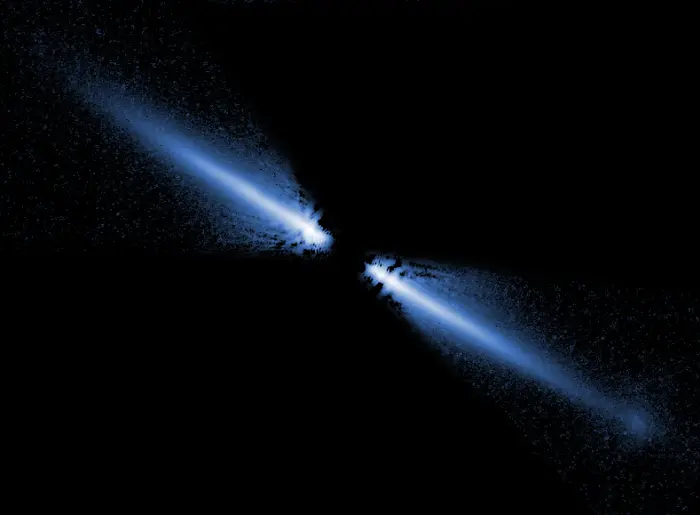
The debris disk around AU Microscopii by the Hubble Space Telescope. Credit: ESA/NASA (PD)
The disk is asymmetrical in shape and appears edge-on when seen from Earth. It was first resolved with the University of Hawaii 2.2-metre telescope on Mauna Kea in Hawaii in 2003.
The asymmetric inner portion of the dust disk – the inner 40 AU – shows structure, indicating that it is affected by larger bodies. Observations with the Hubble Space Telescope in 2010 and 2011 and with the Very Large Telescope in 2015 detected wave-like structures in the disk that are moving away from AU Microscopii at up to 10 km/s. The structures closer to the star are moving away more slowly than those farther away.
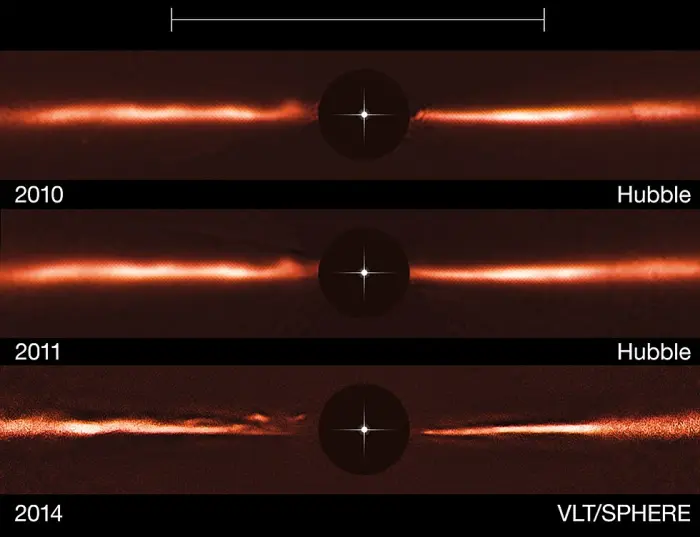
Using images from ESO’s Very Large Telescope and the NASA/ESA Hubble Space Telescope, astronomers have discovered fast-moving wave-like features in the dusty disc around the nearby star AU Microscopii. These odd structures are unlike anything ever observed, or even predicted, before now. The top row shows a Hubble image of the AU Mic disc from 2010, the middle row Hubble from 2011 and the bottom row VLT/SPHERE data from 2014. The black central circles show where the brilliant light of the central star has been blocked off to reveal the much fainter disc, and the position of the star is indicated schematically. The scale bar at the top of the picture indicates the diameter of the orbit of the planet Neptune in the Solar System (60 AU). Note that the brightness of the outer parts of the disc has been artificially brightened to reveal the faint structure. Image credit: ESO, NASA & ESA (CC BY 4.0)
The infrared images captured by the James Webb Space Telescope found similar structures in the debris disk and revealed that the disk contained a lot of fine dust.

This set of images of a 40 billion-mile diameter edge-on disk encircling the young star AU Microscopii reveals a string of mysterious wave-like features. Astronomers discovered the ripples are moving across the disk at speed of 22,000 miles per hour. The cause of the phenomenon is unknown and never-before seen in stellar gas and dust disks. Credits – Top Panel: NASA, ESA, G. Schneider (Steward Observatory), and the HST GO 12228 team;
Bottom Panels: NASA, ESA, ESO, and A. Boccaletti (Paris Observatory) (PD)

: The NASA/ESA/CSA James Webb Space Telescope has imaged the inner workings of a dusty disk surrounding a nearby red dwarf star. These observations represent the first time the previously known disk has been imaged at these infrared wavelengths of light. They also provide clues to the composition of the disk.These two images are of the dusty debris disk around AU Mic, a red dwarf star located 32 light-years away in the southern constellation Microscopium. Scientists used Webb’s Near-Infrared Camera (NIRCam) to study AU Mic. NIRCam’s coronagraph, which blocked the intense light of the central star, allowed the team to study the region very close to the star. The location of the star, which is masked out, is marked by a white, graphical representation at the center of each image. Image credit: NASA, ESA, CSA, and K. Lawson (Goddard Space Flight Center), A. Pagan (STScI) (CC BY 4.0)
Planets
AU Microscopii hosts a planetary system. Two Neptune-sized exoplanets have been discovered orbiting the star to date and the presence of other planets is likely. The planetary system is one of the youngest ones ever discovered. It was detected by the Spitzer Space Telescope and the Transiting Exoplanet Survey Satellite (TESS) in 2020.
AU Microscopii b and AU Microscopii c were discovered in 2020. These are the two confirmed planets orbiting AU Mic. Their discovery was announced in the journal Nature.
AU Microscopii b has a mass of around 10.2 Earth masses and a radius 4.07 times that of Earth. It orbits the parent star at a distance of 0.0645 astronomical units with a period of 8.4630351 days. It is the closest planet to the star, orbiting at only a tenth the distance between the Sun and Mercury.
AU Microscopii c has 14.2 times the Earth’s mass and a radius 3.24 times larger than our planet. It takes 18.85901 days to complete an orbit around AU Mic at a distance of 0.1101 AU.
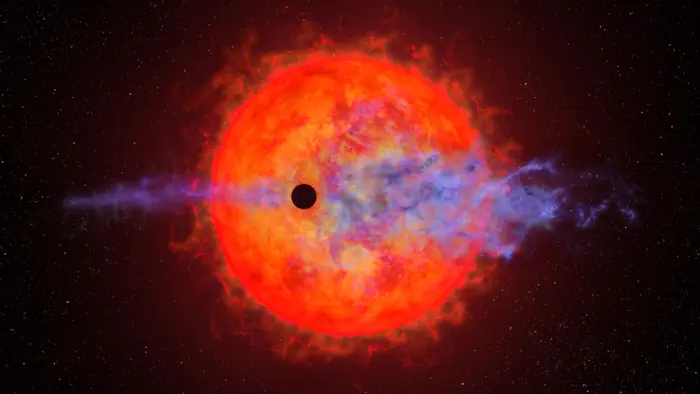
This artist’s illustration shows a planet (dark silhouette) passing in front of the red dwarf star AU Microscopii. The planet is so close to the eruptive star a ferocious blast of stellar wind and blistering ultraviolet radiation is heating the planet’s hydrogen atmosphere, causing it to escape into space. Four times Earth’s diameter, the planet is slowly evaporating its atmosphere, which stretches out linearly along its orbital path. This process may eventually leave behind a rocky core. The illustration is based on measurements made by the Hubble Space Telescope. NASA, ESA, Joseph Olmsted (the Space Telescope Science Institute) (PD)
The presence of AU Microscopii d was suspected since 2022 and announced in 2023. The planet has a mass of 1.053 Earth masses and a radius of 1.02 Earth radii. It has an orbital period of 12.7356 days, but its orbital radius is uncertain. The presence of the super Earth has not been confirmed.
AU Microscopii e is another unconfirmed planet orbiting AU Microscopii. The discovery was announced in 2023. The candidate planet has a mass 35.2 that of Earth and an orbital period of 33.39 days.
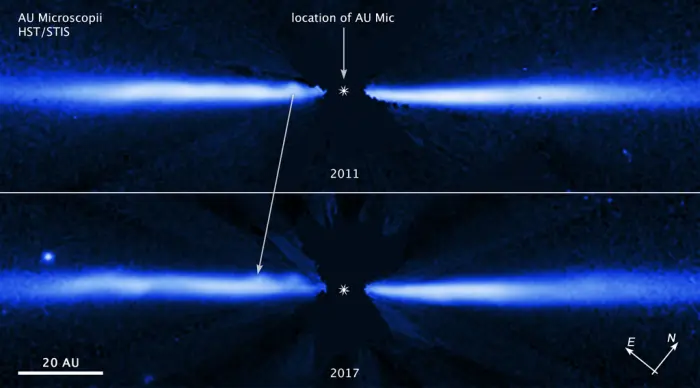
These two images, both taken with the NASA/ESA Hubble Space Telescope, are taken six years apart. They show fast-moving blobs of material sweeping outwardly through a debris disc around the young, nearby red dwarf star AU Microscopii (AU Mic). Red dwarfs are the most abundant and longest-lived stars in our Milky Way. AU Mic, however, is only about 23 million years old, making it a very young star. The top image was taken in 2011; the bottom in 2017. Hubble’s Space Telescope Imaging Spectrograph (STIS) took the images in visible light. This comparison of the two images shows the six-year movement of one of the known blobs (marked by an arrow). Researchers estimate that the blob, which is zipping along at nearly 24 000 kilometres an hour, traveled more than 1300 million kilometres between 2011 and 2017. That is about the distance from Earth to Saturn. Astronomers do not know how the blobs are launched through the system. Eventually, the blob highlighted in the image will sweep through the disc, escape the star’s gravitational grip, and race out into space. Astronomers expect the string of blobs to clear out the disc within 1.5 million years. Their estimated ejection speeds are between 14 000 kilometres per hour and 43 000 kilometres per hour, fast enough to escape the star’s gravitational clutches. They currently range in distance from roughly 1500 million kilometres to more than 8800 million kilometres from the star. Credit: NASA, ESA, J. Wisniewski (University of Oklahoma), C. Grady (Eureka Scientific), and G. Schneider (Steward Observatory) (CC BY 4.0)
In 2023, observations with NASA’s Hubble Space Telescope revealed that the hydrogen atmosphere of AU Mic b is being blasted away by outbursts from the host star. The stellar flares and stellar wind from AU Mic release intense radiation that is evaporating the planet’s atmosphere. As the atmosphere heats, it escapes the planet’s pull and is released into space.
A study led by Keighley Rockcliffe and Elisabeth Newton at Dartmouth College found that the planet was behaving strangely, not showing any atmospheric shedding during one orbit and then shedding its atmosphere into the interstellar medium during the next orbit. The study was published in The Astronomical Journal in 2023.
AU Mic c is also located very close to the star and likely experiencing atmospheric loss.
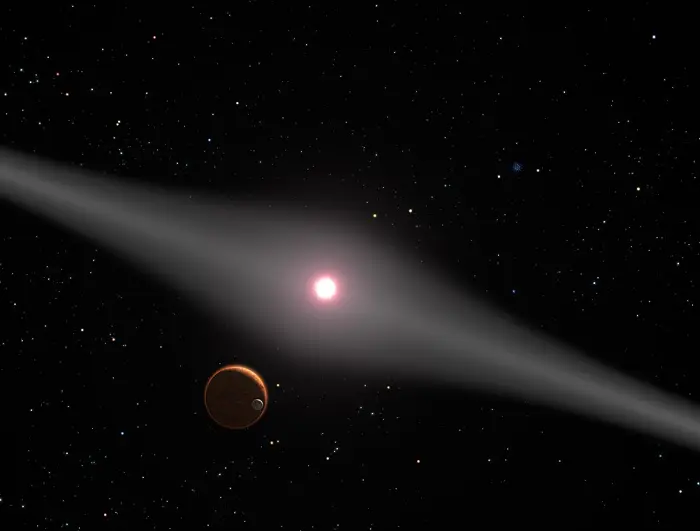
This is an artist’s impression of the view from the vicinity of a hypothetical terrestrial planet and moon orbiting the red dwarf star AU Microscopii. The relatively newborn 12 million year-old star is surrounded by a very dusty disk of debris from the collision of comets, asteroids, and planetissimals swirling around the young star. Though no planets have been discovered around the star, the disk is strong circumstantial evidence for planets. Not only is it dusty, but also it is warped, possibly by the pull of one or more planets. In this view the glow of starlight reflecting off the disk creates a broad lane across the sky because the planet is in the disk’s plane. Similarly, from Earth we see light reflected from interplanetary dust as the zodiacal light (though it is 1/10,000th as dusty as the AU Microcsopii disk). Image credit: NASA/ESA/G. Bacon (STScI) (PD)
Facts
AU Microscopii is a member of the Beta Pictoris Moving Group, a young stellar association located relatively nearby. The title member Beta Pictoris, the second brightest star in the southern constellation Pictor (the Easel), is an A-type main sequence star that lies 63.4 light-years away. Like AU Microscopii, it has a large debris disk and a system of at least two exoplanets.
The stars in the Beta Pictoris moving group formed in the same molecular cloud at around the same time and share a common motion through space. The core of the stellar association lies 115 light-years away. The members are between 20 and 26 million years old. Most of them are faint red and orange dwarfs that are invisible to the unaided eye. They include Eta Telescopii in the constellation Telescopium, 51 Eridani in Eridanus, d Scorpii (HD 146624) in Scorpius, and HD 172555 in Pavo.
AU Microscopii was first identified as a flare star in a study led by William E. Kinkel published in 1973. Kinkel also identified the star as a possible spectroscopic binary system.

The top view, taken with NASA’s Hubble Space Telescope, shows light reflected off dust in a debris disk around the young star AU Microscopii. The bottom frame labels features in this image, while the white lines on the disk indicate the light polarization direction. The image shows the flattened disk, appearing like Saturn’s rings, but seen almost exactly edge-on. Normally, starlight would be so bright that the debris disk could not be seen. But astronomers used the coronagraph on Hubble’s Advanced Camera for Surveys, which blocked out most of the starlight. The black circle in the center of the image is the coronagraph’s occulting disk. The disk in this image extends to about 8 billion miles from the star, or three times farther than Neptune is from the Sun. In other observations, the disk has been traced to at least 11 billion miles. Image credit: NASA, ESA, J. R. Graham and P. Kalas (University of California, Berkeley), and B. Matthews (Hertzberg Institute of Astrophysics) (PD)
Name
AU Microscopii does not have a proper name approved by the International Astronomical Union (IAU). Like most stars invisible to the unaided eye, it does not have a traditional name or a Bayer designation. It is catalogued as HD 197481 in the Henry Draper Catalogue, HIP 102409 in the Hipparcos catalogue, and SAO 212402 in the Smithsonian Astrophysical Observatory Star Catalog.
It is most commonly referred to by its variable star designation, AU Microscopii.

Illustration depicting AU Mic, an M-type red dwarf star less than 0.6% the age of our Sun. The dark areas represent huge sunspot-like regions that helped complicate the search for planets. Credit: NASA’s Goddard Space Flight Center/Chris Smith (USRA) (PD)
Location
AU Microscopii lies in the faint constellation Microscopium, just south of the dim constellation figure of Capricornus. The red dwarf appears just over halfway between Fomalhaut, the brightest star in Piscis Austrinus, and Nunki, the second brightest star in Sagittarius.
Shining at magnitude 8.6, AU Mic is invisible to the unaided eye, but it can be spotted in binoculars and small telescopes. At declination -31° 20’, the star never rises from locations north of the latitude 57-58° N.

The location of AU Microscopii, image: Stellarium
Constellation
AU Microscopii is located in the constellation Microscopium. The celestial Microscope is one of the faintest constellations in the sky. Its brightest star, the yellow giant Gamma Microscopii, shines at magnitude 4.680 from a distance of 223 light-years. It is the second faintest lucida (brightest star in a constellation) in the sky, after Alpha Mensae (mag. 5.09) in the constellation Mensa.
Microscopium is not one of the ancient constellations. It was created by the French astronomer Nicolas-Louis de Lacaille in the 18th century. Lacaille named most of his constellations after different scientific instruments. They are not associated with any myths or folk tales.
Microscopium lies south of Capricornus, east of Sagittarius, west of Piscis Austrinus and Grus, and north of Indus. It stretches across 210 square degrees of the southern sky and is 66th largest of the 88 constellations. It is mostly invisible to northern observers, except for those living in tropical latitudes.

Microscopium constellation map by IAU and Sky & Telescope magazine (Roger Sinnott & Rick Fienberg) (CC BY 4.0)
Notable stars in Microscopium include the yellow giants Gamma and Alpha Microscopii, the Alpha2 Canum Venaticorum variable Theta1 Microscopii, the orange giants Nu Microscopii and 2 Piscis Austrini (which once belonged to Piscis Austrinus), the variable red giant AV Microscopii, the nearby red dwarf AX Microscopii (Lacaille 8760), and the fast-spinning flare star BO Microscopii, nicknamed “Speedy Mic.” The constellation also hosts AT Microscopii, a binary system composed of two red dwarfs classified as flare stars, the symbiotic binary star DD Microscopii, and the Mira variables R Microscopii and S Microscopii.
Deep sky objects in Microscopium include the barred spiral galaxies NGC 6925 and NGC 6923, the unbarred spiral NGC 6925, the intermediate spiral NGC 7060, the elliptical galaxies NGC 7012 and NGC 7057, and the Microscopium Supercluster. The constellation is also home to the Microscopium Void, a region relatively devoid of deep sky objects.
The best time of the year to see the stars and deep sky objects in Microscopium is during the month of September, when the constellation appears higher above the horizon in the early evening. The entire constellation is visible from locations south of the latitude 45° N. It requires clear, dark skies away from city lights to be seen.
The 10 brightest stars in Microscopium are Gamma Microscopii (mag. 4.680), Epsilon Microscopii (mag. 4.71), Nu Microscopii (mag. 4.76), Theta1 Microscopii (mag. 4.82), Alpha Microscopii (mag. 4.89), Iota Microscopii (mag. 5.11), 2 Piscis Austrini (mag. 5.20), HD 201772 (mag. 5.26), Zeta Microscopii (mag. 5.31), and HD 198716 (mag. 5.33).
AU Microscopii
| Spectral class | M1Ve |
| Variable type | Flare star |
| U-B colour index | 1.01 |
| B-V colour index | 1.45 |
| Apparent magnitude (V) | 8.627 ± 0.052 |
| Apparent magnitude (J) | 5.436 ± 0.017 |
| Absolute magnitude | 8.61 |
| Distance | 31.683 ± 0.007 light-years (9.714 ± 0.002 parsecs) |
| Parallax | 102.9432 ± 0.0231 mas |
| Radial velocity | −6.90 ± 0.37 km/s |
| Proper motion | RA: +281.319 ± 0.022 mas/yr |
| Dec.: -360.148 ± 0.019 mas/yr | |
| Mass | 0.60 ± 0.04 M☉ |
| Luminosity | 0.102 ± 0.002 L☉ |
| Radius | 0.82 ± 0.02 R☉ |
| Temperature | 3,665 ± 31 K |
| Age | 23 ± 3 million years, 18.5 ± 2.4 million years |
| Rotational velocity | 8.5 ± 0.2 km/s |
| Rotation | 4.8367 ± 0.0006 days |
| Surface gravity | 4.52 ± 0.05 cgs |
| Constellation | Microscopium |
| Right ascension | 20h 45m 09.5324974119s |
| Declination | –31° 20′ 27.237889841″ |
| Names and designations | AU Microscopii, AU Mic, HD 197481, HIP 102409, SAO 212402, GJ 803, LTT 8214, NLTT 49807, CD -31°17815, CPC 17 11323, CPD-31 6335, GCTP 4939.00, Vys 824, LDS 720 A, GCRV 12995, MCC 824, AKARI-IRC-V1 J2045097-312029, ASAS J204509-3120.3, ASAS J204510-3120.4, PM J20451-3120, Ci 20 1225, TIC 441420236, TOI-2221, UGP 505, UCAC4 294-224065, WEB 18541, WISE J204509.76-312030.9, WISEA J204509.75-312030.9, 2E 4416, 2E 2042.0-3131, Zkh 310, EUVE J2045-31.3, 2EUVE J2045-31.3, RBS 1695, RX J2045.2-3120, 1RXS J204509.4-312023, 1SWASP J204509.52-312027.2, IRAS 20420-3131, 2MASS J20450949-3120266, UBV 17963, TYC 7457-641-1, Gaia DR2 6794047652729201024, Gaia DR3 6794047652729201024, CCDM J20451-3122A, IDS 20390-3142 A, WDS J20452-3120A |